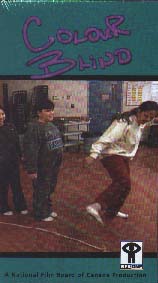|
________________
CM . . . .
Volume VII Number 13 . . . . March 2, 2001
The aims of Colour Blind, a 24 minute video about subtle racism as
it is experienced at a high school in Surrey, BC, are to encourage healthy
dialogue among students and to increase their awareness of racism. Most of
the film deals with the situation at Princess Margaret Senior Secondary
School, a school which experienced a drastic shift in the ethnicity of the
student body between 1995 and 2000, a period during which its previous 80%
white/20% brown student distribution was reversed. According to one of the
teachers, this school has 34 ethnic groups represented. Among the many
different skin colours, cultures and religions, says teacher Angie Hurst,
there is tolerance, but not acceptance. "Racism is right out there, in
your face, like a bad movie."
Throughout the video, groups of students, who presumably have been asked
questions by an unseen interviewer, talk about their experiences with
subtle and not so subtle racism. A group of Grade 11 and 12 white girls
talk about how it feels to have become a minority in their school. They
say the misunderstanding and frustration build up until hate takes over.
Sadly, the viewer hears exactly the same message from a group of brown
boys of the same age. They talk of the desire they have to stick with
their group and of not being able to get rid of their anger. One of them
says, "Sometimes we just want to explode." Shots of racial fighting at a
Halifax school in 1989 are interspersed with these interviews, and they
bring the danger inherent in the situation at this high school shockingly
into focus.
Teachers discussing the issue of racism at a staff meeting at the Princess
Margaret Senior Secondary School admit that the division of students runs
along racial and ethnic lines, and they talk about the change between the
nurturing environment in elementary school, which fosters ethnic mixing,
to the racial tension and divisiveness which characterizes their high
school. The film moves to a three day camping trip set up specifically to
teach kids the skills of being together and of understanding and accepting
each other. The camp experience works wonderfully well with these grade 8
students, but, as one of Grade 11 students remarks, "They should have camp
now...." The viewer is left with the notion that it is too little, and
too late.
Teachers are strongly advised to preview this film before showing it to
students. On the inside of the video case jacket, they will find an
excellent set of questions to ask students prior to viewing. As a
follow-up, 14 open-ended questions intended to give students an
opportunity to examine their own behaviours and attitudes are provided for
teachers.
Though some speakers are identified by a name (first names only in the case of students), many of
the speakers are not identified sufficiently. The viewer does not know what position an adult
speaker holds (is he/she a counselor? a teacher? an administrator?) nor is the institution a person
represents always made clear. A voice-over narration would have enhanced the film's coherency,
and counteracted the disjointed effect of jumping back and forth between groups, individuals and
locations.
Viewing Colour Blind under the guidance of a skillful teacher could lead to students' asking
some important and probing questions of themselves. With proper preparation, the film could be
used by teachers of grade 6 and 7, although it seems most appropriate for Grades 8 to 12.
Recommended with Reservations.
Valerie Nielsen is a retired teacher-librarian who lives in Winnipeg, MB.
To comment on this title or this review, send mail to cm@umanitoba.ca.
Copyright © the Manitoba Library Association.
Reproduction for personal use is permitted only if this copyright notice
is maintained. Any other reproduction is prohibited without
permission.
Published by
TABLE OF CONTENTS FOR THIS ISSUE - March 2, 2001.
AUTHORS |
TITLES |
MEDIA REVIEWS |
PROFILES |
BACK ISSUES |
SEARCH |
ORDER |
CMARCHIVE |
HOME
|
